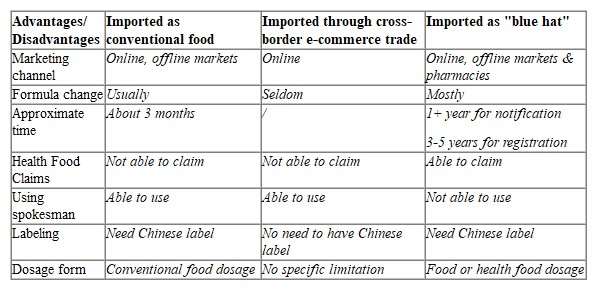


With the economic development in China, health food(which might also be called dietary supplements in other countries) are gradually entering the public's view. Developed countries such as European countries, America, Australia, New Zealand, Japan, and South Korea have mature health food markets, so those foreign companies with well-known brands, high-quality products are warmly welcomed by consumers in China. As a result, today we will talk about the importing channels for importing health food from overseas countries and their advantages and disadvantages. Foodmate has analyzed three main importing channels for importing health food from overseas to provide overseas enterprises a grand view for importing health food to China.
imported as conventional food
Many overseas health foods are imported as conventional food. To import as conventional food, the most important thing is to "fit in a standard" when imported. The standards that are used to "fit in" the most include solid drinks standard, candy tablets standard, gelatin candies standard, and beverage standards. imported as conventional food does not require procedures such as health food registration and notification, making it possible to import and market products in China more quickly. Also, many overseas health food products are in food dosage forms, making consumers feel easy than taking health food in medical forms(like capsules, tablets). For example, the gelatin candy dosage form, as well as many small bottle drinks, are having good market performances. When imported as conventional food, companies should pay attention to the compliance of the formula, and it generally require formula modification to ensure that the product meets the corresponding standards.
imported through cross-border e-commerce trade
Cross-border e-commerce refers to a commercial pattern that Chinese consumers purchase goods through cross-border e-commerce third-party platforms, and goods are imported into China through "online tax declaration import" or "direct purchase import". Compared with general trade patterns, the most important thing is that through cross-border e-commerce, goods are considered as personal self-use import items, so it do not require registration or notification. Also, the goods do not need to meet Chinese standards, they could meet the quality, safety, microbiological, environmental protection, labeling and other standards or technical standards of the origin country. They also do not need to have a Chinese label if the consumers can view the Chinese electronic labels on the website. Enterprises can directly use products that have been legally sold abroad to import through cross-border e-commerce without formula changes or label changes.
imported as "blue hat"
To import health food from overseas countries as "blue hat product", it is undoubtedly the longest and most costly way but also the most compliant way. Products imported as "blue hat product" can not only be sold online and offline in supermarkets, but also in pharmacies, which is more in line with the consumption habits of the elderly population. However, due to China's incomplete health food regulations, there are currently few imported health food categories that can be feasible for "blue hat" importation.
A comparision for 3 importing channels

In conclusion, each way of importing health food has its own advantages and disadvantages. companies can choose the appropriate channel for importation according to their own needs.
If you need further consultation on importing health food to China, Foodmate is always happy to hear from you.
Need help or have a question?
Send mail